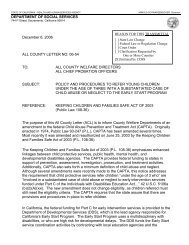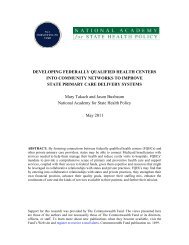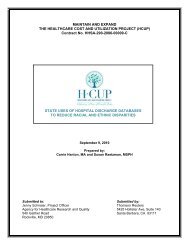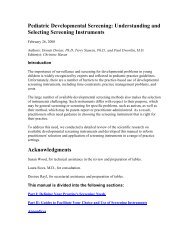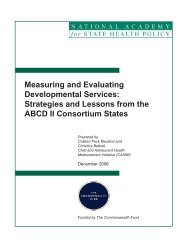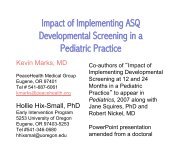Improving Care Coordination, Case Management, and Linkages to
Improving Care Coordination, Case Management, and Linkages to
Improving Care Coordination, Case Management, and Linkages to
Create successful ePaper yourself
Turn your PDF publications into a flip-book with our unique Google optimized e-Paper software.
ne x t steps<br />
States have made great progress in screening for developmental delays. The experience of the ABCD states reveals<br />
four fac<strong>to</strong>rs associated with successful policy <strong>and</strong> practice improvements. They are:<br />
1.<br />
2.<br />
3.<br />
4.<br />
A strategic plan with clarity about goals, objectives <strong>and</strong> policy priorities;<br />
34<br />
Broad stakeholder participation <strong>and</strong> an active public-private partnership that ensures leadership from<br />
all potentially affected agencies <strong>and</strong> organizations are actively engaged from the beginning, <strong>and</strong> that<br />
children’s primary health care provider leadership are explicitly involved;<br />
Grounding proposed policy improvements in experience by pilot testing new ideas with local physician<br />
practices <strong>and</strong> communities <strong>and</strong> collecting data <strong>to</strong> show progress over time; <strong>and</strong><br />
Creating opportunities built on complementary state <strong>and</strong> local initiatives.<br />
Having focused primarily on screening up <strong>to</strong> this point, the ABCD initiative now intends <strong>to</strong> provide focused attention<br />
on improving CC/CM <strong>and</strong> linkages that can improve child development as the result of those screenings.<br />
States need good models, <strong>to</strong>ols, strategies <strong>and</strong> policies for facilitating referrals <strong>and</strong> referral relationships. With<br />
this report, NASHP provides a foundation for a third ABCD Consortium in 2009 that will focus on developing<br />
bridges between primary pediatric health care providers <strong>and</strong> community resources. The collaborative will help<br />
state agencies, especially Medicaid agencies, develop more effective referral pathways <strong>and</strong> linkages between pediatric<br />
practices <strong>and</strong> community intervention agencies, <strong>to</strong> support the healthy development of young children.<br />
<strong>Improving</strong> <strong>Care</strong> <strong>Coordination</strong>, <strong>Case</strong> <strong>Management</strong>, <strong>and</strong> <strong>Linkages</strong> <strong>to</strong> Service for Young Children: Opportunities for States<br />
National Academy for State Health Policy<br />
97



